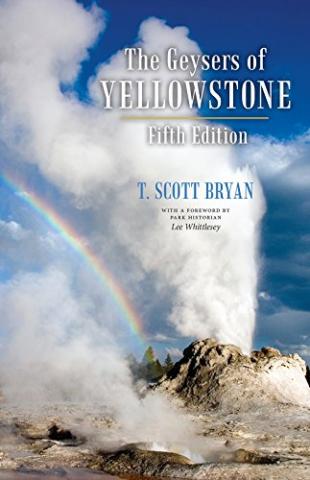This is a book I wish I had encountered, quite literally, decades ago. Now in its fifth edition, The Geysers of Yellowstone by T. Scott Bryan is an encyclopedia of the park's roughly 1,000 geysers.
Within its nearly 600 pages are entries providing locations, descriptions, and in some cases histories, of the park's hot water spouters.
Sapphire Pool gained early notoriety as one of the most beautiful pools in Yellowstone. The crater is of great depth, giving the water an incredibly rich blue color. Since discovery, Sapphire has been known as a geyser. Minor eruptions occurred every few minutes, doming the water about 6 feet high, resulted in heavy overflow.
No spring in Yellowstone was more greatly affected by the 1959 earthquake than Sapphire. On the day after the shocks,the crater was filled with muddy water, constantly boiling with vigor. Four weeks later, Sapphire began having tremendous eruptions. Fully 125 feet high and almost equally wide, these eruptions were among the most powerful ever known in Yellowstone. At first, the intervals were as short as 2 hours, and each play lasted 5 minutes.
Of course, this book is more than just an encyclopedic collection of geysers. Bryan explains the mechanics behind the spouting waters, touches on different kinds of geysers and why some erupt on a somewhat regular schedule while others only when the "mood" strikes, and even includes a section, with some descriptions, on where else in the world you might encounter geysers (Iceland, of course, but also Tibet, New Zealand, the Andes of Chile, and quite a few other countries).
Interestingly, his research has uncovered some particularly fascinating lore tied to Yellowstone's geysers.
Recent studies of historial literature have shown that much about Yellowstone had been forgotten. Many springs taken to be "new" geysers in recent years are now known to have been active during the 1800s. Nevertheless, the number of active geysers appears to be increasing year by year. In 1992, a geochemist with the U.S. Geological Survey, who had conducted studies in Yellowstone for more than fifty years, stated that in 1955 one could easily count the number of geysers on Geyser Hill on two hands. This book enumerates 51 individual or clustered geysers on Geyser Hill, and at least 38 of them were active during 2015. Authors E.T. Allen and A.L. Day of the Carnegie Institute of Washington counted 33 geysers at the Norris Geyser Basin in 1926; 83 are enumerated here. Similar situations exist throughout Yellowstone.
The author also touches on how others through history have perceived, or interpreted geysers. Edouard Riou, a Frenchman, drew an illustration of Grotto Geyser in 1874 that depicted the geyser's cones as towering above human onlookers, while in reality they stand only about 8 feet in height, notes Bryan.
While I've visited the Shoshone Geyser Basin a handful of times through the years, I didn't realize until I picked up this book that the basin "is one of the most important thermal areas in the world, even though its major portion measures only 1,600 by 800 feet. The basin contains at least 107 geysers, probably more than any place on Earth other than the remainder of Yellowstone and, possibly, the Valley of Geysers on Russia's Kamchatka Peninsula."
Bryan provides charts and maps of the geyser basins, so you can easily locate the geysers, know how long their eruptions last, see the time interval between eruptions, and learn how high they spout.
If there are disappointments with this book, one is that the photos are in black and white, that there's not some sort of checklist for you to track how many geysers you've actually seen in person, and, finally, that the publication schedule prevented the author from recounting this year's revival of Steamboat Geyser, which for a period of time was erupting every six to eight days, as opposed to any number of years in between eruptions.
Of course, that's fodder for a sixth edition.





Comments
A great companion tool along with this book is the Geyser Times website:
geysertimes.org